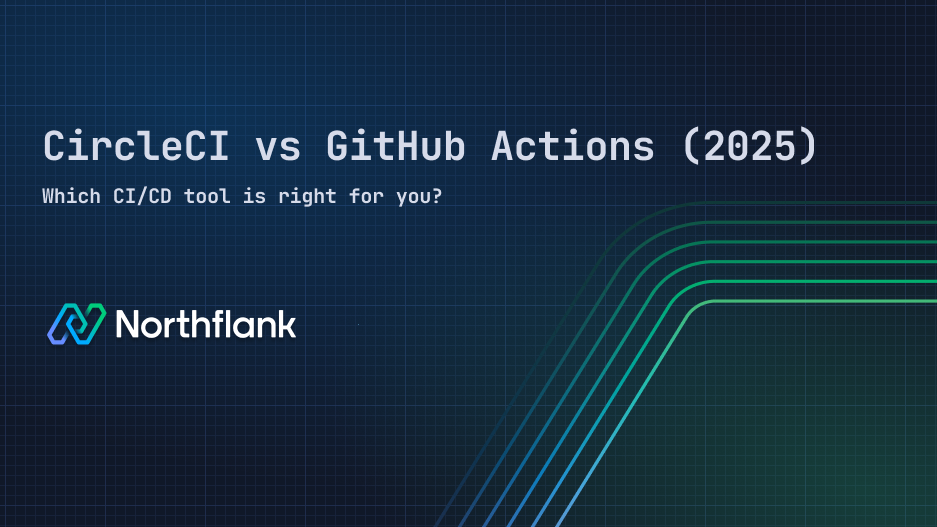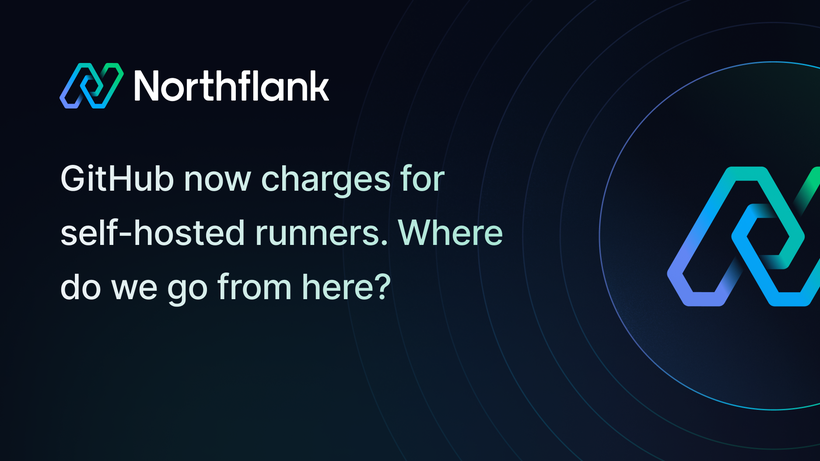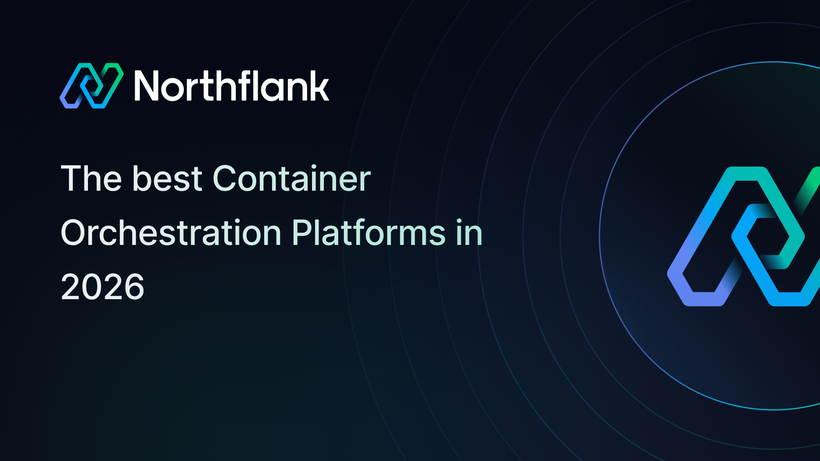

CircleCI vs GitHub Actions: Which CI/CD tool is right for your team?
Let’s be honest, CI/CD is not exactly the most exciting part of building software. But choosing the right tool can save you hours of confusion and frustration later.
If you have ever bounced between GitHub Actions and CircleCI, wondering which one actually fits better with your project and team, you are not alone.
Both promise fast builds and smooth automation, but they feel very different once you start using them for real work. What works for a solo project might be a nightmare at scale.
In this guide, we break down what makes each tool tick using real feedback from developers on Reddit, G2, and other platforms. And if you are thinking, “I just want something that works without duct-taping tools together,” we will show you how platforms like Northflank are offering a more modern way to do CI/CD.
If you’re in a hurry and want a clear view of the differences, this table highlights how CircleCI and GitHub Actions compare across the most relevant areas for teams choosing a CI/CD tool in 2025.
| Feature | CircleCI | GitHub Actions |
|---|---|---|
| Repository support | GitHub, GitLab & Bitbucket | GitHub only |
| Hosting | Cloud or self-hosted servers | GitHub-hosted runners (cloud) or self-hosted runners |
| Setup & UI | Powerful dashboard, detailed logs, allows SSH into jobs | Integrated into GitHub UI; easy to configure via web UI |
| Configuration | Single YAML file (.circleci/config.yml), supports one Docker image per job; uses reusable orbs for common tasks | Multiple workflow YAML files; actions (reusable tasks) from GitHub Marketplace |
| Container support | Native Docker support; also Linux VM, macOS, and Windows runners | Docker-support via runner containers; recently added Linux, Windows, macOS runners |
| Parallelism & scaling | Built-in job parallelism, powerful caching, auto-scaling machines | Limited concurrency on free tier; can self-host runners or pay for more parallel jobs |
| Built-in features | CI/CD pipelines only; needs external tools for hosting/DB | CI/CD plus general workflow automation (issues, releases, etc.) |
| Pricing model | Free tier (6,000 build minutes), paid plans use credits | Free for public repos, paid minutes beyond free tier (2,000 min/mo for private repos) |
| Best for | Teams needing advanced CI features and multi-repo support | GitHub-centric teams and open-source projects |
CircleCI is a CI/CD platform that runs your builds, tests, and deployments whenever you push code. It’s fast, flexible, and works seamlessly with GitHub and Bitbucket. You can run it in the cloud or self-host it if you need more control.
Getting started is simple: you drop a .circleci/config.yml file into your repo. That’s your pipeline — a YAML file that defines what happens when you push. CircleCI reads it and kicks off your jobs in Docker containers or virtual machines.
Here’s a quick example for a Node.js project:
version: 2.1
jobs:
build:
docker:
- image: cimg/node:14.17
steps:
- checkout
- run: npm install
- run: npm test
workflows:
version: 2
build_and_test:
jobs:
- buildWith this, CircleCI installs dependencies and runs tests automatically. It supports parallel jobs, test splitting, SSH access for debugging, and orbs — reusable config snippets for common tasks.
It’s built for CI/CD only, so you’ll still need other tools for infrastructure or hosting, but if you want pipelines that are quick to set up and easy to scale, it’s a solid pick.
GitHub Actions is GitHub’s built-in automation system. It lets you run workflows whenever something happens in your repo, like pushing code, opening a pull request, or creating a new release.
Since it’s built into GitHub, setup is dead simple. No extra tools, no third-party setup. You just create a .github/workflows folder and drop in a YAML file to define your pipeline.
Here’s an example workflow that runs tests on a Node.js project:
name: Run Tests
on: [push, pull_request]
jobs:
test:
runs-on: ubuntu-latest
steps:
- uses: actions/checkout@v3
- uses: actions/setup-node@v3
with:
node-version: 14
- run: npm install
- run: npm testGitHub Actions can handle more than just CI/CD. You can automate labeling issues, sending notifications, deploying apps, or even running scripts on a schedule.
For many teams, it’s a go-to because it’s right there in your repo, easy to use, and backed by a huge marketplace of prebuilt actions. And if you’re building open source, the free tier is pretty generous.
-
It’s built for speed
CircleCI shines when it comes to performance. You can run jobs in parallel, split tests across containers, and use smart caching to cut build times. For larger projects, that adds up fast — a lot of devs say it’s one of CircleCI’s biggest wins.
-
You have full control over pipelines
The
config.ymllets you define every step of your pipeline. You choose the environment, resources, job types (Docker or VM), and more. If your team likes fine-tuning CI, CircleCI gives you room to do it. -
It fits into different setups
Whether your code lives on GitHub, GitLab, or Bitbucket, CircleCI connects easily. It also integrates with major cloud providers like AWS, Azure, and GCP.
-
You can self-host if needed
Want full control or have compliance needs? CircleCI lets you run on your own infrastructure too.
-
Debugging is a breeze
CircleCI’s UI shows detailed logs and makes it easy to jump into failed jobs. You can even SSH into a running build to troubleshoot, which is super helpful when something breaks.
-
Free credits are generous
The free plan comes with 6,000 build minutes monthly, which is usually plenty for small teams or side projects.
-
The setup curve is steeper
Compared to something like GitHub Actions, CircleCI’s YAML syntax and job structure can take a bit of learning. Once you get it, it's powerful — but there's a bit more ramp-up.
-
Pricing can surprise you
CircleCI uses credits to bill for compute time. Some features, like Docker layer caching or parallel jobs, can burn through those quickly, and a few teams mention unexpected usage spikes.
-
It’s not an all-in-one
CircleCI only handles CI/CD. You’ll still need to plug in your own infrastructure, hosting, and deployment logic — it’s not trying to manage everything for you.
-
Support can be hit or miss.
Some users reported great help, while others said support felt slow or limited. It seems to depend on your plan and urgency.
-
It’s already on GitHub
If your code lives on GitHub, using Actions is a no-brainer. No setup, no new accounts — just drop in a workflow file and you’re up and running.
-
You can get started fast
The UI is clean, and GitHub gives you starter templates to build from. Many developers say they had pipelines running in minutes with almost no friction.
-
It’s not just CI/CD
Actions can automate everything from labeling issues to publishing releases. It’s like having a built-in task runner for your whole repo.
-
Free for open-source
Public repos get unlimited free minutes. Even private repos get 2,000 minutes/month for free, which is great for small teams.
-
Huge marketplace of reusable actions
Need to deploy to AWS? Set up Python? Run a linter? The GitHub Marketplace has thousands of plug-and-play actions ready to go.
-
You’re locked into GitHub
It only works if your code is hosted on GitHub. If you use GitLab, Bitbucket, or host your own Git server, GitHub Actions isn’t an option.
-
Scaling can hit limits
For small projects, GitHub-hosted runners are fine. But bigger teams sometimes hit queuing delays or need to pay for faster machines or self-hosted runners to keep up.
-
Complex workflows can get messy
Basic CI is easy, but once you’re dealing with multiple services, environments, or lots of secrets, the YAML gets harder to manage. It can feel limiting for advanced setups.
-
Not ideal if you’re not all-in on GitHub
If your workflow spans across other tools or platforms, GitHub Actions starts to feel more restrictive. It works best when everything is already inside the GitHub ecosystem.
| Category | CircleCI | GitHub Actions |
|---|---|---|
| Repo support | Works with GitHub, GitLab and Bitbucket (cloud or self-hosted) | Only works with GitHub repositories |
| Platform integration | Standalone service focused on CI/CD — requires integration with GitHub/GitLab/Bitbucket | Fully built into GitHub — CI, code, and automation in one place |
| UI & setup | Separate dashboard with detailed insights, SSH access, and fine-grained control | Simple GitHub UI, starter templates, logs in the Actions tab |
| Workflow structure | One config.yml per project (free tier limited to one Docker image per job). Uses “orbs” for reusable logic | Multiple .yml files per repo, each triggered by events. Uses reusable community “actions” |
| Performance & scaling | Built-in parallelism and autoscaling, better suited to high-concurrency workloads | GitHub-hosted runners have limits unless you pay or self-host |
| Pricing | Credit-based pricing (with a generous free tier). Can become costly for heavy parallel builds or advanced features | Free tier includes 2,000 minutes/month for private repos (unlimited for public), usage-based beyond that |
If GitHub Actions feels too limited and CircleCI too heavy to maintain, you’re not out of options.
Northflank gives you built-in CI/CD with the flexibility of a self-managed platform, without the usual overhead. You don’t have to set up runners, manage agents, or wire together a bunch of services. Just connect your repo, define a build method like a Dockerfile or buildpack, and your service is ready to go.
You can deploy on Northflank-managed infrastructure or bring your own cloud and run everything on your own Kubernetes cluster.

Northflank includes CI/CD that runs on every push, plus logs, metrics, secrets, and container builds — all from one interface. It supports background jobs, cron tasks, and preview environments without needing extra tools or plugins.
You’re not locked into GitHub. You can use any Git provider, including self-hosted.
Northflank also supports GPU workloads without the friction. Unlike CircleCI, you don’t need a high-tier plan or custom setup.

If you want more control than GitHub Actions but less maintenance than CircleCI, Northflank might be the right balance. It’s fast to get started and is designed to stay out of your way.
See how it works or try it free.
The right tool depends on where your code lives, how your team works, and what you’re building.
-
Fully on GitHub?
GitHub Actions is built in — simple, clean, and great for teams that want minimal setup.
-
Using Bitbucket or multiple repos?
CircleCI works well across platforms and gives you more control over pipelines.
-
Small project or prototype?
Actions’ free tier and ease of use are hard to beat. CircleCI’s parallelism and speed can really help larger projects with long test suites.
-
Need more than just CI/CD?
CircleCI is focused on pipelines, and GitHub Actions is flexible across GitHub workflows.
Want both CI/CD and built-in app hosting? Northflank gives you everything — pipelines, deployments, environments, and more in one seamless platform.
-
Trying to stay on budget?
GitHub Actions is free for public repos and light usage. CircleCI’s free tier is generous, but costs can add up at scale. Northflank has predictable pricing with built-in infrastructure, so you get fewer surprises.
-
Team experience?
GitHub Actions is great for beginners, while CircleCI is more suited to experienced teams that need fine-tuned control. Northflank sits comfortably in between — powerful yet developer-friendly.
You don’t need the most popular tool. Just the one that fits your code, your team, and what you’re building.
GitHub Actions makes it easy to get started. It’s built right into GitHub, so you can add a workflow file and go. For many teams, that’s more than enough, especially for lightweight CI and simple automation.
CircleCI gives you more control. You can fine-tune your pipelines, run jobs in parallel, choose your execution environment, and manage caching more precisely. But with that flexibility comes a bit more complexity in setup and maintenance.
What if you need both?
You might want fast setup, but without giving up visibility or customization. Or maybe you want built-in CI/CD that works across clouds, without managing runners or patching things together with plugins.
That’s where Northflank comes in.
It combines the simplicity of Git-based automation with the power of container-native workflows — no extra tools, no custom infrastructure. Everything from builds and deployments to logs, metrics, secrets, and environments lives in one place.
If GitHub Actions feels too limited, and CircleCI starts to feel like a project of its own, Northflank could be the middle ground that just works.
Take a look at the quickstart guide, or create a free account to try it for yourself.


